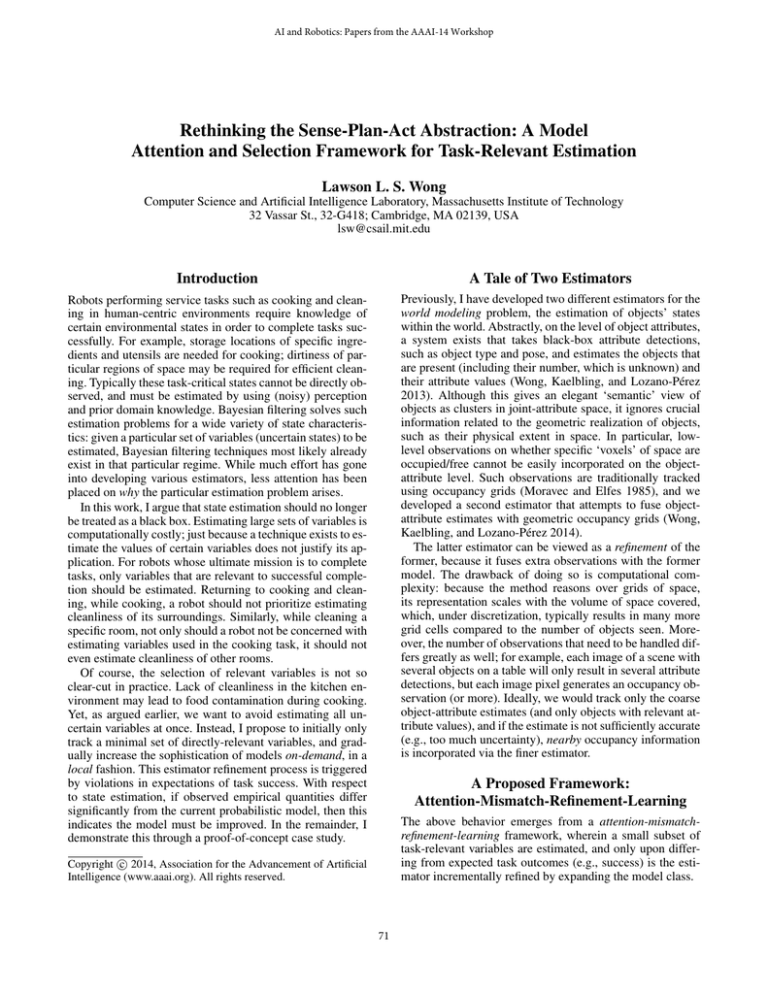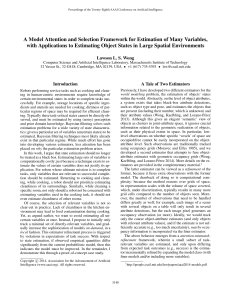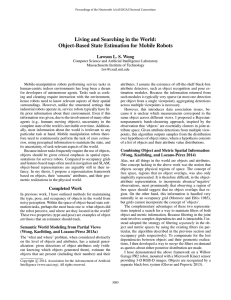
AI and Robotics: Papers from the AAAI-14 Workshop
Rethinking the Sense-Plan-Act Abstraction: A Model
Attention and Selection Framework for Task-Relevant Estimation
Lawson L. S. Wong
Computer Science and Artificial Intelligence Laboratory, Massachusetts Institute of Technology
32 Vassar St., 32-G418; Cambridge, MA 02139, USA
lsw@csail.mit.edu
Introduction
A Tale of Two Estimators
Robots performing service tasks such as cooking and cleaning in human-centric environments require knowledge of
certain environmental states in order to complete tasks successfully. For example, storage locations of specific ingredients and utensils are needed for cooking; dirtiness of particular regions of space may be required for efficient cleaning. Typically these task-critical states cannot be directly observed, and must be estimated by using (noisy) perception
and prior domain knowledge. Bayesian filtering solves such
estimation problems for a wide variety of state characteristics: given a particular set of variables (uncertain states) to be
estimated, Bayesian filtering techniques most likely already
exist in that particular regime. While much effort has gone
into developing various estimators, less attention has been
placed on why the particular estimation problem arises.
In this work, I argue that state estimation should no longer
be treated as a black box. Estimating large sets of variables is
computationally costly; just because a technique exists to estimate the values of certain variables does not justify its application. For robots whose ultimate mission is to complete
tasks, only variables that are relevant to successful completion should be estimated. Returning to cooking and cleaning, while cooking, a robot should not prioritize estimating
cleanliness of its surroundings. Similarly, while cleaning a
specific room, not only should a robot not be concerned with
estimating variables used in the cooking task, it should not
even estimate cleanliness of other rooms.
Of course, the selection of relevant variables is not so
clear-cut in practice. Lack of cleanliness in the kitchen environment may lead to food contamination during cooking.
Yet, as argued earlier, we want to avoid estimating all uncertain variables at once. Instead, I propose to initially only
track a minimal set of directly-relevant variables, and gradually increase the sophistication of models on-demand, in a
local fashion. This estimator refinement process is triggered
by violations in expectations of task success. With respect
to state estimation, if observed empirical quantities differ
significantly from the current probabilistic model, then this
indicates the model must be improved. In the remainder, I
demonstrate this through a proof-of-concept case study.
Previously, I have developed two different estimators for the
world modeling problem, the estimation of objects’ states
within the world. Abstractly, on the level of object attributes,
a system exists that takes black-box attribute detections,
such as object type and pose, and estimates the objects that
are present (including their number, which is unknown) and
their attribute values (Wong, Kaelbling, and Lozano-Pérez
2013). Although this gives an elegant ‘semantic’ view of
objects as clusters in joint-attribute space, it ignores crucial
information related to the geometric realization of objects,
such as their physical extent in space. In particular, lowlevel observations on whether specific ‘voxels’ of space are
occupied/free cannot be easily incorporated on the objectattribute level. Such observations are traditionally tracked
using occupancy grids (Moravec and Elfes 1985), and we
developed a second estimator that attempts to fuse objectattribute estimates with geometric occupancy grids (Wong,
Kaelbling, and Lozano-Pérez 2014).
The latter estimator can be viewed as a refinement of the
former, because it fuses extra observations with the former
model. The drawback of doing so is computational complexity: because the method reasons over grids of space,
its representation scales with the volume of space covered,
which, under discretization, typically results in many more
grid cells compared to the number of objects seen. Moreover, the number of observations that need to be handled differs greatly as well; for example, each image of a scene with
several objects on a table will only result in several attribute
detections, but each image pixel generates an occupancy observation (or more). Ideally, we would track only the coarse
object-attribute estimates (and only objects with relevant attribute values), and if the estimate is not sufficiently accurate
(e.g., too much uncertainty), nearby occupancy information
is incorporated via the finer estimator.
A Proposed Framework:
Attention-Mismatch-Refinement-Learning
The above behavior emerges from a attention-mismatchrefinement-learning framework, wherein a small subset of
task-relevant variables are estimated, and only upon differing from expected task outcomes (e.g., success) is the estimator incrementally refined by expanding the model class.
c 2014, Association for the Advancement of Artificial
Copyright Intelligence (www.aaai.org). All rights reserved.
71
(a) Task: Locate red objects in
1-D domain with 4 objects
(b) Initial task-relevant estimator: Red objects only
(c) Naı̈ve estimator: Estimate
all variables
(d) After refinement: Includes
task-correlated variables
Figure 1: Locating unknown red objects in the 1-D domain (black line). Curves above objects represent Gaussian distributions
on the object’s centroid. Shaded boxes below the line show a discretized occupancy grid, where darker shades indicate greater
probabilities of being occupied. Different estimators keep track of different sets of variables; those not shown are ignored.
• Attention: Task relevance.
Without constraints, the model can always be refined until
the level of raw data (model-free). For many tasks, however, only a small subset of variables benefit the task with
additional accuracy. Intelligent systems need a way to ‘focus’ on relevant variables for given tasks.
The performance of this estimator is therefore mismatched
for the task, and therefore estimator refinement is necessary.
The refinement process involves adding new variables to
the estimator and estimating their values based on a buffer of
lazily-stored recent observation values. Variables are ranked
and added (up to a threshold) if they provide sufficient improvement in expected cost f (·) (in this case, f = variance):
f (pX|Y ) , Ey∼pY f (pX ) − f (pX|Y =y )
Z
pY = pY |X=x pX (x) dx
• Mismatch: Fault detection.
If deviations between expected and observed values exceed thresholds, informed by the task, the current model
is inadequate, and must be refined. Possible techniques
for determining the task-informed thresholds for triggering refinement include execution monitoring (Pettersson
2005), Bayesian optimization (Snoek, Larochelle, and
Adams 2012), and metareasoning (Cox and Raja 2011).
This leads to the addition of two sets of variables. The first
set, for the left red object, is a subset of occupancy grid
cells; their primary purpose is to distinguish the boundary
of the object more finely. The second set, for the right red
object, is more interesting: not only does it include associated occupancy grid cells, it also includes the attribute-level
variables of the nearby blue object. This latter variable is
helpful because of the domain constraint that objects cannot
overlap each other, which introduces correlations between
the states of the two objects (Wong, Kaelbling, and LozanoPérez 2012). Incorporating these new variables in the refined estimator sufficiently reduces the variance for successful task completion.
• Refinement: Model class expansion.
Once a relevant variable’s model is identified as inadequate, a larger model class should be explored, for a small
subset of related variables only. In principle, any hierarchy of estimators and models should work; possible methods include using grammars that generate increasinglycomplex models (Grosse, Salakhutdinov, and Tenenbaum
2012), and a recent approach that uses a hierarchical decomposition of variables to produce a partition of variables with varying fineness (Steinhardt and Liang 2014).
References
• Learning: Estimating parameters.
Expanded model classes will have additional parameters
to be learned. Non-parametric ‘models’ (empirical estimates) can be used as a final refinement.
Cox, M. T., and Raja, A., eds. 2011. Metareasoning: Thinking
About Thinking. MIT Press.
Grosse, R.; Salakhutdinov, R.; and Tenenbaum, J. 2012. Exploiting
compositionality to explore a large space of model structures. In
Uncertainty in Artificial Intelligence (UAI).
Moravec, H., and Elfes, A. E. 1985. High resolution maps from
wide angle sonar. In IEEE Intl. Conf. on Robotics and Automation.
Pettersson, O. 2005. Execution monitoring in robotics: A survey.
Robotics and Autonomous Systems 53:73–88.
Snoek, J.; Larochelle, H.; and Adams, R. 2012. Practical Bayesian
optimization of machine learning algorithms. In Advances in Neural Information Processing Systems (NIPS).
Steinhardt, J., and Liang, P. 2014. Filtering with abstract particles.
In Intl. Conf. Machine Learning (ICML).
Wong, L. L. S.; Kaelbling, L. P.; and Lozano-Pérez, T. 2012.
Collision-free state estimation. In IEEE Intl. Conf. on Robotics
and Automation (ICRA).
Wong, L. L. S.; Kaelbling, L. P.; and Lozano-Pérez, T. 2013. Constructing semantic world models from partial views. In Intl. Symp.
on Robotics Research (ISRR).
Wong, L. L. S.; Kaelbling, L. P.; and Lozano-Pérez, T. 2014. Not
seeing is also believing: Combining object and metric spatial information. In IEEE Intl. Conf. on Robotics and Automation (ICRA).
Case Study: 1-D Colored Intervals Domain
As a proof-of-concept, consider the domain and task depicted in Figure 1(a). The task is to locate (to some specified
uncertainty tolerance) red objects on the real line, given a list
of ‘images’ as input, each of which contains a small set of
noisy attribute (location, length, and color) detections and
a larger set of occupancy observations. The naı̈ve solution
is to run all estimators on all the observations, as depicted
in Figure 1(c). Since the task is to locate only red objects,
this approach, while sound, is inefficient, especially if the
domain is significantly larger and contains few red objects.
Instead, consider the estimator in Figure 1(b). Only objects whose color attribute is red with high probability are
given attention; the rest is discarded/ignored. This is conceivably the minimal estimator for the task. However, these
observations are very noisy (e.g., the output of an entire
object detection pipeline) and lead to large variance in the
posterior attribute distribution, above the required tolerance.
72









